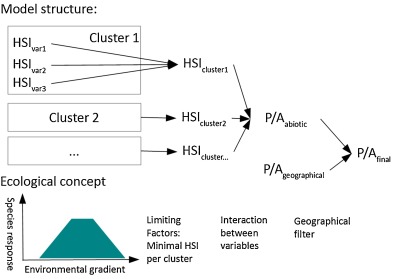Bennetsen, E., Gobeyn, S., & Goethals, P. L. M. (2016). Species distribution models grounded in ecological theory for decision support in river management. Ecological Modelling, 325, 1-12.
DOI: 10.1016/j.ecolmodel.2015.12.016

River managers must restore their systems with limited budgets and answer to conflicting stakeholders, and as such can be subjected to increased scrutiny. When planning restoration it is important to understand the stressors within the system and as such there has been more effort applied to the development of ecological models in European river systems. These models are often more related to ecological quality indices than actual species distribution models. While SDMs are often used to assess impacts of stressors on a system, the difficulties in modeling multiple species within the system has made application in riverine conservation difficult. The authors present a model for which they use species distribution of multiple species to assess the environmental condition of rivers throughout the landscape. This project comprised of six steps, (1) development of model concept, (2) data exploration and preparation, (3) construction of habitat suitability indices, (4) implementation of model concept, (5) model selection and assessment, and (6) meta-analysis of model results. The authors built a general model concept in which environmental stressors act as hierarchical environmental filters upon the realized species assemblages. This model is structured as abiotic filters in the form of habitat suitability indices which result in possible species assemblages. The model included 34 environmental variables to explain species assemblages. Habitat suitability indices were derived for each univariate from the trapezoid curve of the species distribution along an environmental gradient. In order to predict the presence of a species, HSI were combined as limiting abiotic filters. If HSI scores were low for many environmental variable the probability of presence of a species would decrease. Four models were constructed (one with just abiotic factors, one that included a geographic filter, one that included interactions of parameters, and one that included both the geographic filter and the interactions of parameters) to test the effect of model structure on prediction. HSIs were constructed for 92 taxa. The model that included both the geographical filter and the interaction parameter had the best performance. All models showed high agreement with known species distributions and ecological knowledge of individual species. Model performance differed strongly between species and as there is no relationship between how well a model agrees with ecological knowledge and the final model performance; improvements to the HSI are unlikely to improve model performance. The inclusion of stakeholders in model development resulted in credible and acceptable models which are able to handle multiple species at once and aid in the prediction of species assemblages across river systems. This type of species distribution relies heavily on prior knowledge regarding species response to environmental stressors, and as such differs from modern species distribution approaches. While this model can be easily interpreted and may be more likely to be accepted by stakeholders in the management of these rivers, more modern algorithmic based models may provide better prediction of species distributions in the system.
